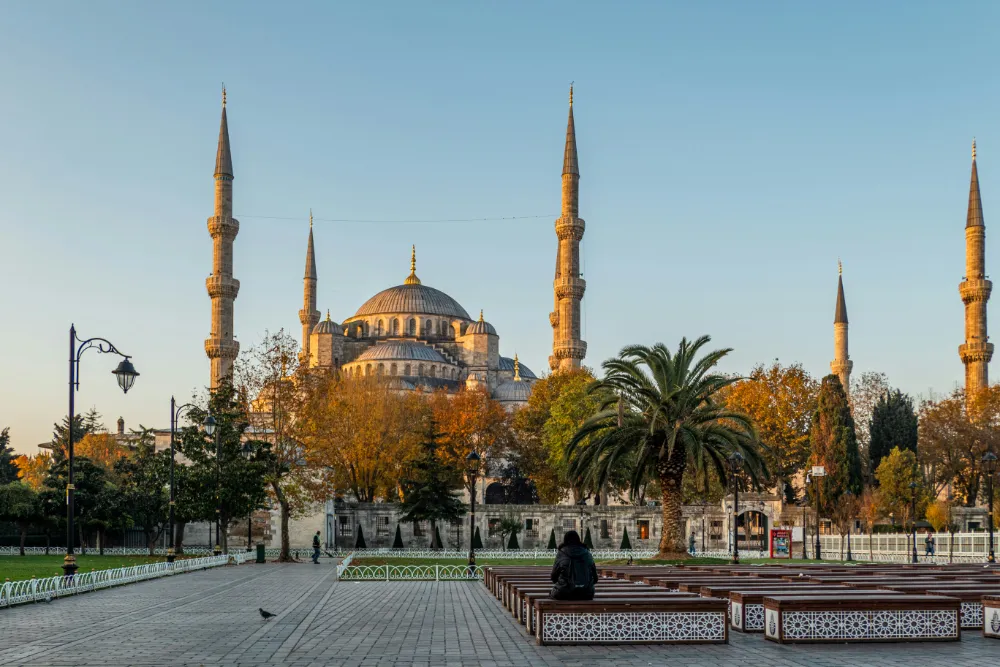Travel
Best Time to Visit Turkey: Complete Seasonal Guide (Updated 2025)
Straddling two continents, Turkey bridges East and West, blending ancient history with modern culture against diverse landscapes.
When planning your trip to Turkey, timing is crucial. With coastal temperatures soaring to 113°F (45°C) in summer while central regions plunge below freezing in winter, the best time to visit Turkey depends significantly on which regions you plan to explore.
This guide will help determine the ideal time for your Turkish adventure, whether you’re drawn to hot air balloon rides over Cappadocia, cultural immersion in Istanbul, or beach relaxation along the coast.
Need Affordable Mobile Data While In Turkey?
Did you know that you can have incredibly cheap high-speed mobile data anywhere in the world without needing to install a new SIM card?
Just jump off the plane and connect instantly.
No rushing around or standing in long queues to find a SIM card dealer.
No need to overpay for global roaming either.
Simply choose a mobile data plan, download it to your phone (check here to see if your phone is compatible) and activate right before you leave (or when you hop off the plane) and you are connected instantly to the mobile networks.
Click here to find the best mobile data rates for your trip.
Quick Answer: When to Visit Turkey
For travelers seeking the perfect balance of comfortable weather, manageable crowds, and reasonable prices, the best time to visit Turkey is during the shoulder seasons:
| Travel Priority | Best Time | Why |
|---|---|---|
| Best Overall | Spring (April-May) and Fall (mid-September to mid-November) | Pleasant temperatures, fewer crowds, vibrant landscapes |
| Budget Travel | Late Fall (November) and Winter (except holiday periods) | Lowest prices on accommodations and flights |
| Good Weather | Late Spring (May) and Early Fall (September) | Warm days, cool evenings, minimal rainfall |
| Fewer Crowds | Early Spring (April) and Late Fall (October) | Major sites are less congested while weather remains agreeable |
| Times to Avoid | Peak Summer (July-August) for major tourist areas | Extreme heat, maximum crowds, highest prices |
Keep in mind that Turkey’s regional climate variations are significant. While coastal areas enjoy mild Mediterranean conditions, central Anatolia experiences continental extremes. Istanbul remains compelling year-round, though spring and fall offer the most comfortable conditions for exploring the city on foot.
Understanding Turkey’s Climate
Turkey’s geography creates several distinct climate zones, making it crucial to understand regional variations when planning your visit.
The Mediterranean coast (including Antalya and Fethiye) enjoys classic Mediterranean climate with hot, dry summers and mild, wet winters. Summer temperatures regularly reach 86-95°F (30-35°C), while winter rarely drops below 50°F (10°C).
The Aegean coast offers a similar but slightly milder pattern, with refreshing sea breezes making summer heat more bearable.
Central Anatolia (including Cappadocia) experiences a continental climate with hot, dry summers and cold, sometimes snowy winters. Summer days can exceed 86°F (30°C), while winter temperatures commonly drop below freezing.
The Black Sea region stands as Turkey’s wettest area, with year-round precipitation. Summers are cooler and more humid than the Mediterranean, making this region a refreshing alternative during peak heat.
Eastern Turkey experiences harsh winters with heavy snowfall and mild summers. January is the coldest month in Turkey, particularly in this region where mountain ranges create alpine conditions.
Seasonal Breakdown: What to Expect
Spring in Turkey (March-May)
Spring transforms Turkey into a vibrant paradise as the countryside erupts with wildflowers and temperatures rise to comfortable levels. In Istanbul and coastal regions, March begins with average highs of 55°F (13°C), warming to a pleasant 73°F (23°C) by May. Cappadocia sees April temperatures ranging from 41-68°F (5-20°C).
The Istanbul Tulip Festival (typically April) sees millions of tulips creating stunning mosaics throughout the city’s parks. The International Istanbul Film Festival (April) attracts cinema enthusiasts worldwide, making it a great time to visit Istanbul for culture lovers.
Spring offers fewer crowds at major archaeological sites, vibrant landscapes, and moderate prices before the summer surge. It’s an excellent time for photography, with clear light and blooming backdrops, though early spring can bring unpredictable rain showers.
This is an ideal time to visit Cappadocia for hot air balloon rides with calm morning conditions. The dream-like landscape viewed from a hot air balloon during spring months creates unforgettable memories as you float over the fairy chimneys and unique rock formations.
| Aspect | Details |
|---|---|
| Temperature | • Istanbul/Coast: 55°F (13°C) in March → 73°F (23°C) by May<br>• Cappadocia: 41-68°F (5-20°C) in April |
| Events | • Istanbul Tulip Festival (April)<br>• International Istanbul Film Festival (April) |
| Advantages | • Fewer crowds at archaeological sites<br>• Vibrant landscapes with wildflowers<br>• Moderate prices<br>• Excellent photography conditions<br>• Ideal for Cappadocia hot air balloon rides |
| Considerations | • Unpredictable rain showers in early spring |
Summer in Turkey (June-August)
Summer brings Turkey’s most intense heat, particularly in Mediterranean and inland areas. Coastal destinations like Bodrum and Antalya regularly see temperatures between 86-95°F (30-35°C), while inland cities can reach 100°F (38°C). Istanbul is hot and humid, averaging 82°F (28°C) but feeling warmer.
This is undeniably beach season along Turkey’s stunning coastlines, with Mediterranean water temperatures reaching a perfect 80°F (27°C). Turkey in June sees the beginning of peak tourist season, with vibrant cultural celebrations including the Istanbul Music Festival.
Perfect beach weather makes this the ideal time for swimming and water sports. Long daylight hours maximize sightseeing time, and the festive atmosphere creates a lively environment. However, extreme heat can make exploring inland archaeological sites uncomfortable, and major attractions see peak crowds and highest annual prices.
During a July visit to Ephesus, I learned that ancient wisdom still applies—Romans built their cities with marble streets that reflect morning light, making them unbearable by noon. If you plan to visit in July, schedule archaeological visits for early morning (8am), retreat during midday heat, then re-emerge for evening explorations after 4pm.
| Aspect | Details |
|---|---|
| Temperature | • Coastal areas (Bodrum, Antalya): 86-95°F (30-35°C)<br>• Inland cities: Up to 100°F (38°C)<br>• Istanbul: Averaging 82°F (28°C), humid |
| Water Temperature | • Mediterranean: 80°F (27°C) |
| Events | • Istanbul Music Festival<br>• Beginning of peak tourist season in June |
| Advantages | • Perfect beach weather<br>• Long daylight hours for sightseeing<br>• Vibrant, festive atmosphere |
| Considerations | • Extreme heat at archaeological sites<br>• Peak crowds<br>• Highest annual prices<br>• Best to visit sites early morning (8am) or late afternoon (after 4pm) |
Autumn in Turkey (September-October)
Autumn offers Turkey’s most balanced and pleasant climate. September begins with summer warmth—coastal areas around 82°F (28°C) and Istanbul around 77°F (25°C)—gradually cooling through October. The Mediterranean Sea retains its warmth well into October, extending the swimming season.
September and October coincide with olive and grape harvests, making it an ideal time for culinary tourism and wine tasting in regions like Cappadocia and the Aegean coast. Cultural events include the International Istanbul Biennial (in odd-numbered years) and the Antalya Golden Orange Film Festival in October.
Pleasantly warm days with cooler evenings create ideal sightseeing conditions during autumn. Tourist crowds thin significantly after mid-September, while prices drop from summer peaks. The landscape transitions to golden hues, especially beautiful in areas like Yedigöller National Park amidst fir forests.
Fall in Cappadocia brings ideal conditions for hot air balloon rides—cool, calm mornings with enhanced visibility after summer haze dissipates. The valleys glow with amber and gold as vineyards change color, creating a photographer’s paradise against the region’s fairy chimneys.
| Aspect | Details |
|---|---|
| Temperature | • Coastal areas: Starting at 82°F (28°C) in September<br>• Istanbul: Starting at 77°F (25°C), gradually cooling |
| Events | • Olive and grape harvests<br>• International Istanbul Biennial (odd-numbered years)<br>• Antalya Golden Orange Film Festival (October) |
| Advantages | • Pleasant days with cooler evenings<br>• Fewer crowds after mid-September<br>• Lower prices than summer<br>• Beautiful golden landscapes<br>• Ideal conditions for Cappadocia balloon rides |
| Considerations | • Mediterranean Sea remains warm for swimming through October |
Winter in Turkey (December-February)
Winter transforms Turkey into a study of contrasts. Along the Mediterranean coast, days remain mild (57-64°F/14-18°C) despite cooler evenings. Istanbul experiences average highs of 48°F (9°C) with occasional snow flurries that magically dust its domes and minarets. Central and eastern regions face true winter conditions, with Cappadocia often blanketed in snow and temperatures regularly below freezing. December to February represents the coldest period throughout the country.
This season brings excellent skiing opportunities, positioning Turkey as a skiing destination at resorts like Uludağ near Bursa and Palandöken near Erzurum. Winter also features distinctive celebrations including New Year’s festivities.
Winter delivers the year’s lowest prices (except during holiday periods), authentic local experiences away from tourist crowds, and snow-covered landscapes that transform familiar sites into winter wonderlands. If you want to visit Turkey on a budget, this is considered the best season for travelers watching their expenses.
During a January visit to Istanbul, I experienced the deep pleasure of huddling in a café near the Blue Mosque, sipping salep (a warm orchid-root drink) while watching snowflakes swirl around Hagia Sophia. The slower winter pace allowed for meaningful conversations with locals eager to share their city without the summer rush.
| Aspect | Details |
|---|---|
| Temperature | • Mediterranean coast: Mild days 57-64°F (14-18°C), cooler evenings<br>• Istanbul: Avg. high 48°F (9°C), occasional snow<br>• Central/Eastern regions: Below freezing, snow common in Cappadocia |
| Activities | • Skiing at Uludağ (near Bursa) and Palandöken (near Erzurum)<br>• New Year’s celebrations |
| Advantages | • Lowest prices of the year (except holidays)<br>• Authentic local experiences<br>• Beautiful snow-covered landscapes<br>• Best season for budget travelers |
| Considerations | • Coldest period throughout the country |
Month-by-Month Guide
January: The coldest month brings serene, snow-covered landscapes to central regions. Istanbul averages 43°F (6°C) with occasional snow. Peak season for winter sports, with excellent skiing and hot springs in Pamukkale providing welcome warmth.
February: Winter continues with slightly milder temperatures. Istanbul sees averages of 45°F (7°C). Valentine’s Day brings special packages at luxury hotels. This can also be a good time to experience Turkish hamams (baths) at their traditional best.
March: Early spring brings gradual warming and blooming landscapes. Istanbul reaches 50°F (10°C), while Mediterranean regions warm to 63°F (17°C). March to May represents the beginning of ideal sightseeing weather.
April: Spring fully arrives with comfortable temperatures nationwide. The Istanbul Tulip Festival brings millions of blooms to parks citywide. This is a perfect time to explore Istanbul’s historic sites without summer crowds and excessive heat.
May: May offers perhaps the most pleasant weather nationwide. Istanbul enjoys 73°F (23°C) days, coastal regions reach 77°F (25°C), and even Cappadocia warms to comfortable levels. May is the best month for hiking before summer heat arrives.
June: Early summer brings warm temperatures across Turkey. Beach season begins along Mediterranean and Aegean coasts. The Istanbul Music Festival creates a festive atmosphere, making it a great time to enjoy both cultural events and outdoor activities.
July: Peak heat arrives with temperatures regularly exceeding 86°F (30°C) nationwide. Coastal resorts operate at full capacity with vibrant nightlife. The ancient theater at Aspendos hosts international performances during this expensive time to visit.
August: Turkey’s hottest month sees coastal temperatures regularly exceeding 90°F (32°C). This is the busiest beach month with European holiday crowds, representing the absolute peak tourist season in Turkey.
September: Early autumn brings relief from summer heat while maintaining warm temperatures. Grape harvests begin in wine regions, and crowds thin after the first week. September is considered by many to be the best month to visit for balanced experiences.
October: Golden autumn light bathes Turkey as temperatures moderate. Olive harvests begin, and food festivals celebrate the season’s bounty. October offers the perfect balance of good weather and minimal crowds.
November: Late autumn brings cooler temperatures and increasing rainfall. This is the cheapest shoulder season month with significant price drops nationwide and very few tourists.
December: Winter arrives with cooler temperatures and holiday preparations. Christmas and New Year celebrations create a festive atmosphere, especially in Istanbul’s cosmopolitan neighborhoods.
Best Times by Travel
Families with Children: Late May to early June and September offer comfortable temperatures without extreme heat that can make children cranky. You’ll find fewer crowds at major attractions while still enjoying pleasant weather for outdoor activities.
Budget Travelers: November and February-March (excluding holidays) provide the cheapest rates on accommodations and flights. Early spring also presents excellent value before Easter tourism begins.
Beach Lovers: June and September offer the perfect combination of warm sea temperatures without overwhelming crowds. September is particularly ideal as the Mediterranean holds heat well into autumn.
History Enthusiasts: April-May and October provide comfortable temperatures for exploring ancient sites without exhausting summer heat. With fewer crowds, you can take your time examining historical treasures without feeling rushed.
Photography Enthusiasts: Spring brings extraordinary natural light to Turkey’s landscapes, while autumn creates magical golden hour conditions. Winter can also offer dramatic photographic opportunities when snow dusts ancient monuments.
Planning Tips
Visa Requirements: Most visitors need an e-Visa for Turkey, obtainable through the official government website at least one week before departure. E-Visas are typically valid for multiple entries over 180 days, with stays up to 90 days.
Booking Timeline: For summer travel (June-August), book accommodations and flights 4-6 months in advance, especially for coastal resorts. For shoulder seasons, 2-3 months ahead is generally sufficient, while winter travelers can often find good deals with less advance planning.
Transportation: Domestic flights offer the most efficient way to cover Turkey’s vast geography, especially in winter when road conditions in mountainous regions may be challenging. The high-speed train network connects major cities like Istanbul, Ankara, and Konya with comfortable service.
Mosque Etiquette: When visiting Turkey’s magnificent mosques, dress modestly (shoulders and knees covered), women should bring a scarf to cover their hair inside, and remove shoes before entering. Visit outside prayer times, particularly Friday midday.
The best time and season to visit Turkey depends entirely on your priorities. Whether you’re seeking sun-soaked beaches, uncrowded historical sites, or cultural immersion, this diverse country offers ideal conditions somewhere in its calendar. May and September to November generally provide the most balanced experience for first-time visitors, combining good weather with reasonable crowds and prices. If you plan to visit Istanbul and Cappadocia together, spring and fall months offer ideal conditions for exploring both destinations. For those who want to take a hot air balloon ride over Cappadocia’s magical landscape, the clear, calm mornings of September and October provide perfect conditions along with stunning autumn colors.
As the Turkish saying goes, “A cup of coffee commits one to forty years of friendship.” No matter when you choose to visit Turkey, the warmth of its people will ensure your trip becomes a cherished memory that lasts far longer than your stay.







